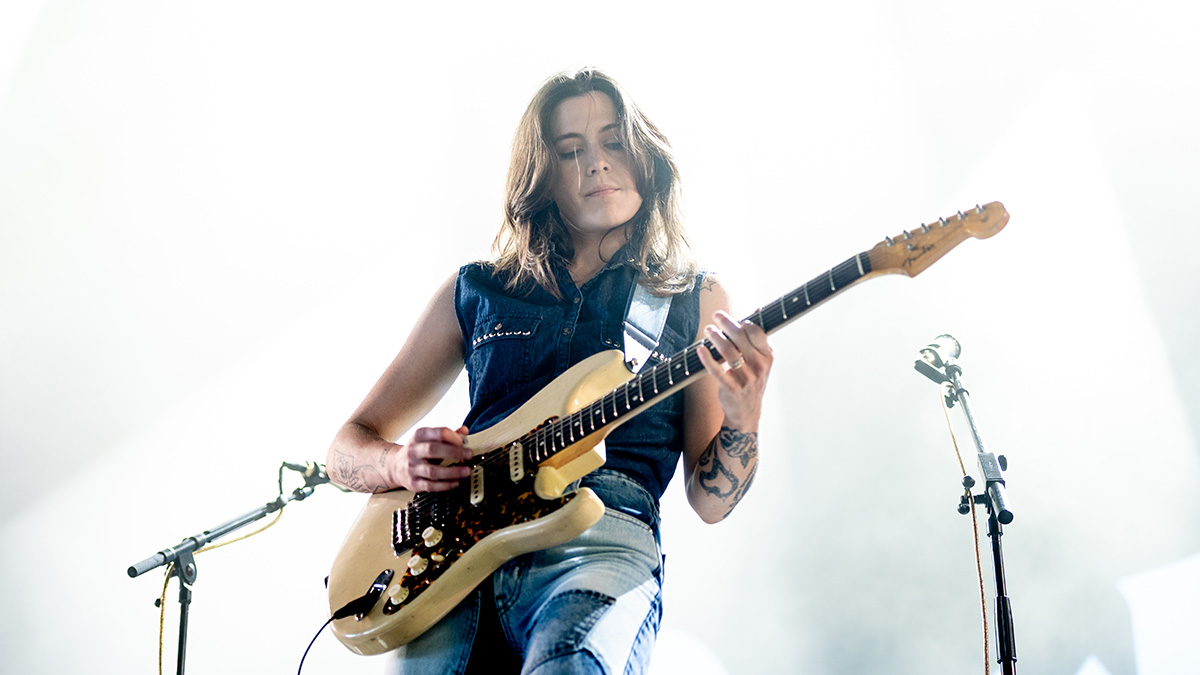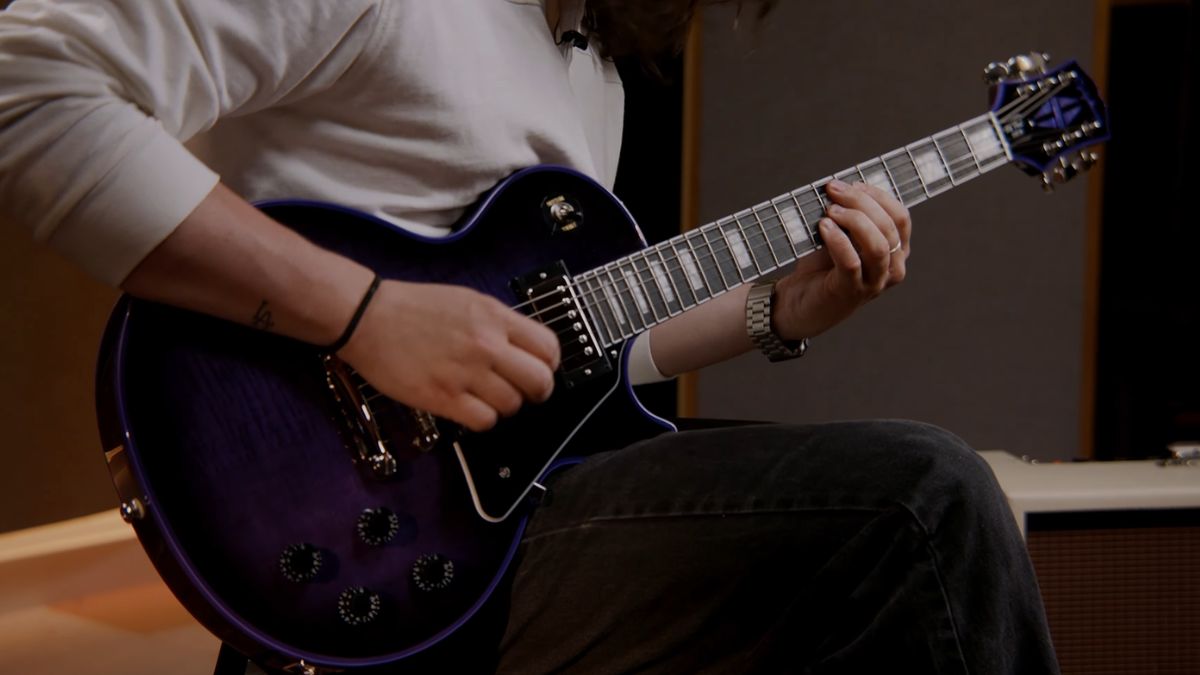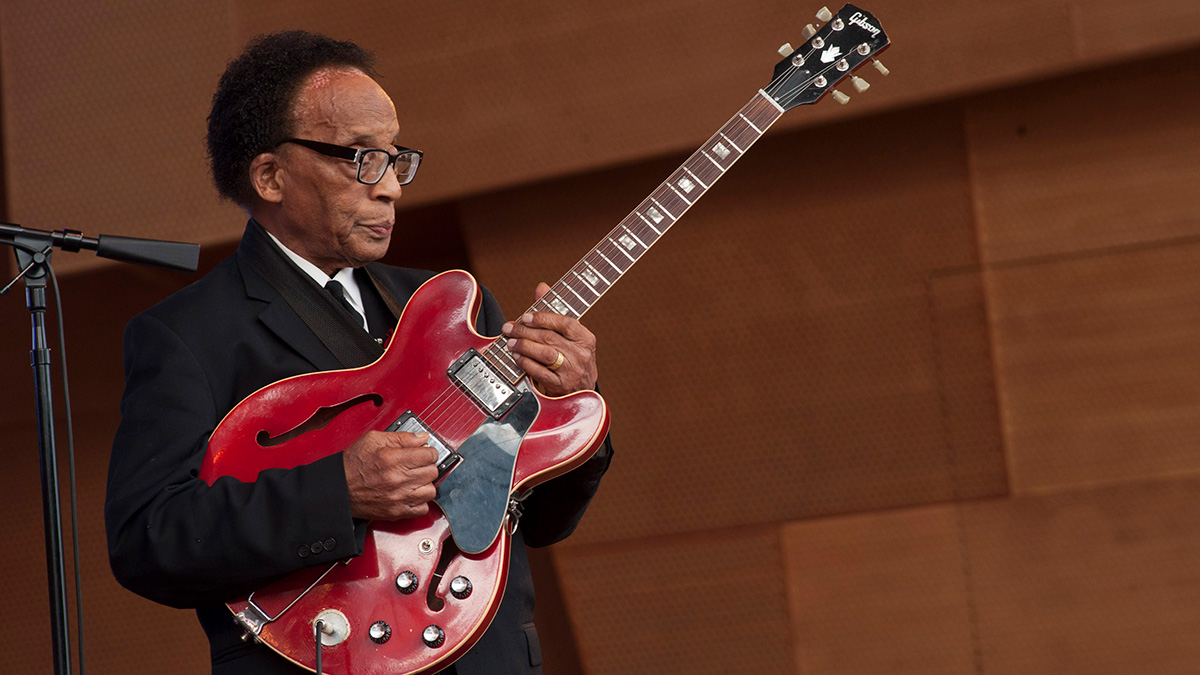Baroness: "It was easier for us to paint a picture with Fenders than Les Pauls"
John Baizley and Gina Gleason reveal the gear overhaul and studio experimentation behind one of 2019's best albums, Gold & Grey

“My favorite disgusting comparison was when we were on tour last summer and my tooth got knocked in. First it turned grey, and I had to get it pulled. Now it’s gonna be gold!”
That’s Baroness’ new lead guitarist, Gina Gleason, on the gnarly physical connection between the title of the progressive hard rock outfit’s fifth full-length release, Gold & Grey, and her tour-damaged maw.
Its album cover, illustrated by vocalist-guitarist John Baizley, fittingly surrounds a series of female figures and ginger-feathered birds with clusters of excised molars and grey-plated chisels.
If you’ve been with the band since they broke out of Savannah, Georgia, alongside contemporaries Mastodon and Kylesa, you’ll know these kinds of color studies are a recurring theme.
Given Baizley’s background as a painter - in addition to having created all the hypnotic and surrealistic album covers for Baroness, he’s done designs for Metallica, Skeletonwitch and many more - it’s fitting that the group are just as conceptual with modern metal soundscaping as they are about exploring the color wheel.
Even their light show bathes the quartet - which includes bassist/keyboardist Nick Jost and drummer Sebastian Thomas - in purposeful shades inspired by their back catalog: 2007’s Red Album, 2009’s Blue Record, 2012’s Yellow & Green and 2015’s Purple.
I would hate it if we put out a record and our fans collectively said, ‘This is the Baroness sound, we don’t want anything else.’ That would be a bummer
John Baizley
When Guitar World meets up with the guitarists beneath the stage of Vancouver’s Vogue Theatre, midway through a co-headlining trek with American black metal crew Deaf-heaven, the aesthetics are fittingly as juxtaposed as their latest album title.
Get The Pick Newsletter
All the latest guitar news, interviews, lessons, reviews, deals and more, direct to your inbox!
Though seated together behind a broken maple desk in a pallid beige side room, its walls paint-peeled and pocked with suspiciously fist-sized craters, Gleason and Baizley are vividly reflecting upon the textures and hues of Gold & Grey, a double-sized release that finds Baroness happily splattering the canvas in a more experimental mindframe than their last LP.
You could argue that the pulse-quickening pace of 2015’s especially anthemic Purple was heavily influenced by the band’s frightening brush with death in 2012, after their tour bus plunged off of a UK highway.
Of the many injuries sustained in the crash, Baizley broke his left leg and needed extensive surgery to rebuild his crushed left fretting arm. Despite this, he pledged he’d be back at it with Baroness ASAP and began the slow process of rehabilitation.
Heavy on life-affirming bangers like Shock Me, the record was a triumphant return, but longtime lead guitarist Pete Adams, who’d been with Baizley since 2008, amicably bowed out from the band in 2017 after their set at Netherlands’ Roadburn Festival.
Around that same time, Gleason - a shredder who’d cut her teeth with tribute act Misstallica and as a touring musician with Cirque Du Soleil - started jamming with Baizley in his Philadelphia-area basement, a casual arrangement that eventually led to her being drafted into Baroness.
As songwriting partners, they began crafting what would become Gold & Grey, working out demos at Baizley’s home studio before the full band once again hooked up with Purple producer Dave Fridmann at his Tarbox Road Studio in upstate New York. The end result is an epic, artfully aggressive 17-song conclusion to Baroness’ 'color series'.
With room to breathe, Baroness sound bold and liberated, unafraid to co-mingle savage, serpentine metal licks, like back in the Savannah days (Throw Me an Anchor, Front Toward Enemy), with subtly complex prog-pop (Borderlines), effects-heavy krautrock jamming (Can Oscura), Americana-to-avant garde electro-acoustic conceptualism (Blankets of Ash) and even some echo-heavy piano balladry (I’d Do Anything).
It’s a kaleidoscopic approach that Baizley wants Baroness to explore even more in the future.
“I would hate it if we put out a record and our fans collectively said, ‘This is the Baroness sound, we don’t want anything else.’ That would be a bummer,” Baizley reveals, while contemplating the sonic possibilities beyond Gold & Grey.
“I think we could do an acoustic record, a super-sludgy and screamy record, a record with gigantic choruses and soaring leads or something that didn’t have the normal setup for our band. We can do any of those kinds of things and it would make sense, which is a very exciting place to be in.”
With Gleason and Baizley gleefully gelling on and off stage - they also sync up together during morning runs at most tour stops - the Baroness guitarists tell Guitar World all about Gold & Grey, and what life is like at the other end of the rainbow.

Gina, the news that Pete was leaving the band and that you were joining dovetailed into each other in 2017. Prior to that, how did you enter Baroness’ sphere?
Gina Gleason: "Basically, I ordered a fuzz pedal online from Philly Fuzz, which John is a part of. It’s two friends in Philadelphia; they build these pedals and John tests them. I ordered one online because I thought they were rad.
"I was living in Nevada and told them, 'Yo, instead of shipping it all the way up here, I’m going to be in Philly visiting my family and I can pick it up.' John sent me a message: 'Do you want to test out these pedals with me? We should meet up and jam!'
"Pete was still in the band at that point; I just chilled in John’s basement for eight hours trying different fuzz pedals - 'This one has a germanium transistor; this one has a silicone transistor.' We geeked out on this gear, jammed and played thrash riffs and punk songs together."
What pedal did you end up gravitating toward?
I’ve always hated the idea that when you invite a new member to the band, you have to hold auditions and make it this formal thing. Six line-ups later, we have yet to do a proper audition
John Baizley
Gleason: "I was looking at the Philly Fuzz Heretic Fuzz pedal when we first met. Then John was like, 'Maybe you could learn some Baroness songs for the next time we get together.' So I did. It never felt like, 'Now you’re auditioning for Baroness.' It was more, 'Learn these songs, come down this one weekend.' We played Morningstar and Shock Me.
John Baizley: "I’ve always hated the idea that when you invite a new member to the band, you have to hold auditions and make it this formal thing. Six line-ups later, we have yet to do a proper audition.
"Honestly, I try to make it vague when there could be something like that going on. Who wants the pressure? The whole idea is to see whether or not there’s some chemistry. That’s not going to happen if you’re like, 'Well, after you we have six more people showing up, so you’d better do well!'"
Gleason: "I think the real pressure kind of came after. [I] have to uphold the integrity of Pete’s style and also try to find a way [to play] that’s still going to sound like me."
What was the first piece that you put together for the record?
Gleason: "The first piece I remember working on with these guys was Tourniquet, which, from where it was initially to now, is completely different."
Was the all-in, ornate acoustic intro there to begin with?
Gleason: "The idea for the acoustic intro came after the fact. John and I were playing acoustic a lot and trying to get inside that riff. We just got really good at playing a stripped-down version of it and thought it would be cool."
Baizley: "One day we were upstairs listening to some music and were doing that thing everybody does now where you lament the pre-iPod days, where people would listen to your whole record.
"And we got on this discussion of playlists - [albums are] just not how people listen anymore. But if I’m being honest, it’s kind of like how I listened to music in high school, on cassettes. If there’s a cute girl in your class, you can make a mixtape for her, and she makes a mixtape for you. It’s cool because the vibe changes; the sound and emotional content changes.
We have to be an album band, but why wouldn’t we just fuckin’ go for the idea of having things evolving constantly on our album?
John Baizley
"I think the playlist idea, the DJ’ing of the world, has brought that back to the forefront in a very different way. I thought, 'Why fight it?' We have to be an album band, but why wouldn’t we just fuckin’ go for the idea of having things evolving constantly on our album?
"Along with that ran the idea that we could do this thing that we tried a lot with Blue, which was to reimagine and reinterpret melodies across the scope and breadth of an album. It’s not a unique thing - it’s a classical music technique; I recognized it on a Queen album. We did a pretty good job of it with Blue; we did a psychotic job of it with this one."
Being that you bonded over effect pedals, what were some of the new sonic tricks you had planned on coloring the songs with once you hit the studio?
Baizley: "You can’t ask this band what they were, because there’s no way to keep track of it. Starting with Red, I came up with this method. It’s pretty simple: If you do it once successfully, don’t ever do it that way again. If you come up with a great combination, try as hard as you can to alter it every time. Being pedal enthusiasts makes that really easy."
Gleason: "I tried hard to keep track of that stuff in the first session in my notebook - 'John’s been using this pedal at these settings' - but by the second session I was like, 'I don’t know if I need to do this.'"
What were the guitars you ended up using on Gold & Grey?
Baizley: "We used a Jazzmaster on every song, at least once."
Gleason: "There’s baritone on I’d Do Anything. Dave has this late-'60s Melody Maker that we used somewhere."
Baizley: "Strats, Teles, Jazzmasters - and Gina’s got this really nice '80s G&L. Basically those. Every once in a while I’ve got a really Vintage 333 with P-90s in it, but you’re mostly listening to Fender guitars and Fender amps.
"Over the years I’ve found that more modern sounds haven’t quite done it for me. When we started in the early ‘00s, it was during the very big Les Paul-and-Marshall phase of music. It was either that, or the PRS-style guitars with scoopy, processed sounding amplifiers - triple racks and 5150s.
"I’m not trying to bad-mouth them, because they’re fantastic amps and guitars to play, but I started to play Fenders because [producer] John Congleton had some in his studio when we were doing Yellow & Green.
Starting with clean guitars and adding on top of that, instead of just having the sound blow your head off
Gina Gleason
"My analogy, as a painter, is that it’s like using this one brush all the time, and you know how to paint a wall with it. But then you get a real nice one, and you can express yourself more fluidly, and effortlessly. That was a thing I found through the Fenders - single coil, more headroom, less high-gain amps, a more front-end affectation on your sound. I found that it was just easier for me to paint a picture, so to speak.
"Also, with Les Pauls, I find they feel a little stuffy. The sound is so full and robust that you can’t sculpt it without removing things. You can’t add to it. There’s already too much there! With Fenders, even with just a Strat or the five-way-switch, you really do have five different recognizable sounds. You know, it’s just stuff like that. And it’s like a little more like we’re voicing things like they did in the '60s."
Gleason: "I still love the sound of a Marshall head and a Les Paul - it’s indisputable! - but it just seemed like with this, we were going for something where we wanted to layer more and have fun. Starting with clean guitars and adding on top of that, instead of just having the sound blow your head off."
Baizley: "The records I’ve heard more recently that have adventurous guitar sounds on them, they were pretty much never that format. They were always the [Fender-heavy] format I’m talking about.
"And Gina and I have actively started incorporating more fingerstyle guitar playing into our electric technique - more of a folk style than a chicken-picking Nashville style. Definitely more Americana-influenced."
Gleason: "And with a Tele, you get a more surgical tone. I’ve always played Jackson Dinkys or Kramer SM-1’s, stuff that had Floyd Roses on them, but it didn’t seem appropriate for learning the back catalog of Baroness songs. I thought I should seek out a Tele just to get a weirder, more interesting tone."

Going back to the folkier side of your playing, Tourniquet has a very clean intro, while Blankets of Ash has rustic acoustics meshing with what sounds like a broken EDM bass drop. How are these helping push Baroness into new territory?
Baizley: "We’re re-establishing something we neglected on Purple. Prior to that, there was always a track that was just an acoustic, melodic piece with vocals. Gina and I had written a bunch of stuff that sounded really nice, and so we have some of that that made it into the record."
I’d Do Anything focuses more on decaying piano and strings than guitar. Can you explain the creation of that track?
Gleason: "It was an acoustic song John and I were jamming on, but trying to find if there was a way to make it more amped up. Broken Halo is that [version of the] song."
Baizley: "Gina’s responsible for the melodies and composition of I’d Do Anything. [To Gina] I think you were nervous to have that song on the record. On every record there’s been somebody new to the process that has something where they’re like, ‘I’ve got this, but I don’t know if it’s right for Baroness.’
"For me, as a listener, I’m going, ‘That’s right!’ I never forgot that the mellow version of that became I’d Do Anything. In fact, I was waiting for the rhythm section to not be around [in the studio].
"They were a little lukewarm on it, but I felt strongly that that was a song, tone and texture that our record needed. We tried to make it a guitar song, but really quickly Dave [Fridmann] was like, 'Let’s pull those guitars out.'"
Moving on to a more guitar-centric track, can you talk about the different layers behind Borderlines? There are some hard, mid-heavy Telecasters twanging early on, but later you’re flooding the mix with some of the album’s filthiest distortion.
Baizley: "That’s my favorite sound on the record, right after the chorus. That’s DI through Dave’s old Ampex compressors, which are hot-rodded to distort, or at least one of them was."
Gleason: "Yeah, a lot of that song is DI guitar."
Baizley: "The first verse is one of my favorite guitar segments on the record. Gina’s playing that funny little riff that sounds like it’s in seven, but it’s not. It’s kind of bizarre!
The interesting thing with this record is that it was always changing. It wasn’t about trying to capture a specific sound
John Baizley
"[To Gina] You were trying to get a clean, smooth, compressed sound, but you kept turning up - everything was getting turned up - and it was hitting one of Dave’s super-funky compressors so hard that it just started distorting. It was just this really, really aggressive twang. I looked over and thought, 'Aw fuck, that’s sick!'"
Gleason: "It’s just one of those SP Xotic compressors, the little mini ones on my pedalboard. I think I was just fucking with that… I [also] like that weird chorus [effect]; it’s like a sound that you find on a Bad Brains record, that weird punk chorus - horrible sound [laughs].
"I was just fucking around with a Whammy pedal and found that just in the middle, neither an octave above or below, is where you get that weird chorus effect."
Baizley: "It’s always chaotic getting as many ideas out as you can before the clock stops ticking. But with Purple, it was important to go, 'This song has these five sections, and these are the ways we’re going to achieve these five sounds.'
"The interesting thing with this record is that it was always changing. It wasn’t about trying to capture a specific sound - half the time we didn’t know what the song was going to be about [until we finished]."
How does Gold & Grey apply to the broader themes of your discography?
Baizley: "We were going to call it Orange."
Gleason: "But we didn’t want it to be called Orange. We had this massive group text about it, and realized that there was a lyrical motif with the words 'gold' and 'grey' throughout the record. It’s not on purpose, at least not consciously."
Baizley: "It was made in a similar way to Yellow & Green. It’s definitely where I would have wanted to have proceeded after Yellow & Green, had we not undergone the accident we’d been involved in.
We finished a whole rainbow’s worth of album titles, and what do you find at the end of the rainbow? Gold!
John Baizley
"It’s got the scope of it as well, and it’s a double record, so it plays to that type of [two-color] title. It’s also a part of the lyrical ideology, this juxtaposition. You’ve got gold, and you’ve got grey - something that is illuminated, shiny and valuable, and something that is largely perceived to be the dullest descriptor for anything.
"It worked well conceptually from that standpoint - the lyrics are about that stark contrast that we, as a species, are constantly forced to deal with. There’s also stupid shit that keeps coming up, when we think about it. We finished a whole rainbow’s worth of album titles, and what do you find at the end of the rainbow? Gold! [laughs]
"I was talking to someone last week about it. They brought up these things about our band that were sort of self-prophesying.
"When we did Yellow & Green, in the first big interview I did I said what I was trying to do with the artwork [was convey the moment] before the knife hits the throat and kills you. Or that moment when time slows down right before a horrific car accident, that brief period before the car hits the ground. Of course, then the bus did hit the ground.
"Then people were talking about Purple being the color of bruises, or something like that. The week I read that, I fell down and was bruised to fuck-all. There’s something like that on all the records. Now everybody’s losing their teeth [laughs]."
Gleason: "I think it reflects the mirroring aspect of the record, too, like with I’d Do Anything mirroring Broken Halo."
Baizley: "It’s like there’s a gold version and grey version - one’s melancholic, and the other is triumphant."
How does it feel to be at this precipice, closing a major chapter of Baroness while also looking toward the future?
Baizley: "It’s supposed to be terrifying to put out a record, right?… If there’s something that satisfies our needs as artists, and that hopefully challenges our audience to open up the way they have a relationship with our band, or even music in general? If we’re trying for goals as lofty as that, there’s no way to do it without putting yourself in a lane nobody else is occupying.
The scary thing is with finishing up a 12-year concept. I committed myself a long time ago to something I didn’t think the band would have the lifespan to see through
John Baizley
"It wouldn’t be an easy thing to say, 'How does this Baroness record stand up to this Gojira record or Ghost record?' or whatever the hot-ticket band is. I think some people are going to hate [Gold & Grey], but people that know what we’re about, they have the opportunity here to really dive in with us. So that’s exciting.
"The scary thing is with finishing up a 12-year concept. I committed myself a long time ago to something I didn’t think the band would have the lifespan to see through. Where do we go from here?
"It’s not like we’re starting a new band, but we’re stopping a theory and a concept we’ve been chasing for over a decade. I’m excited about that, to not feel locked into an idea. It’s liberating.
"But then again, the idea is kind of cool. If we get even more specific with [colors], and find those alternate tangents? Well, the merch table would look increasingly insane. [laughs]"
Gregory Adams is a Vancouver-based arts reporter. From metal legends to emerging pop icons to the best of the basement circuit, he’s interviewed musicians across countless genres for nearly two decades, most recently with Guitar World, Bass Player, Revolver, and more – as well as through his independent newsletter, Gut Feeling. This all still blows his mind. He’s a guitar player, generally bouncing hardcore riffs off his ’52 Tele reissue and a dinged-up SG.
“The main acoustic is a $100 Fender – the strings were super-old and dusty. We hate new strings!” Meet Great Grandpa, the unpredictable indie rockers making epic anthems with cheap acoustics – and recording guitars like a Queens of the Stone Age drummer
“You can almost hear the music in your head when looking at these photos”: How legendary photographer Jim Marshall captured the essence of the Grateful Dead and documented the rise of the ultimate jam band

















